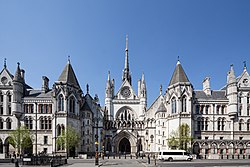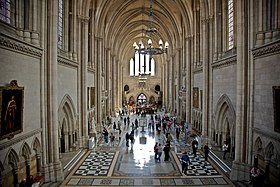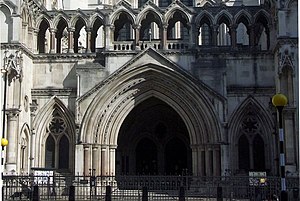Royal Courts of Justice
| Royal Courts of Justice | |
|
Middlesex | |
|---|---|
 The Royal Courts of Justice on The Strand | |
| Type: | Court house |
| Location | |
| Grid reference: | TQ31028110 |
| Location: | 51°30’49"N, 0°6’48"W |
| City: | Westminster |
| History | |
| Built 1873 – 1881 | |
| By: | George Edmund Street |
| Court house | |
| Gothic | |
| Information | |
| Owned by: | The Crown |
The Royal Courts of Justice are an exuberant Victorian Gothic building on The Strand, at the boundary between the Cities of London and Westminster, and in the latter. Since it was first built in the 1870s, the Royal Courts of Justice have expanded into a complex of buildings, still dominated by the Victorian original.
The grand entrance, with a high, funnel-like Gothic arch, is a familiar sight from the News, and campaigners of all sorts are frequently seen milling outside in the hope of a newsman's camera.
The building houses the High Court and Court of Appeal of England and Wales, and modern additions latterly provide a home for the Central London County Court. The High Court also sits on circuit and in other major cities, but here is its principal centre.
The building was designed by George Edmund Street, who died before it was completed, inspired by the Palais de Justice in Paris. Built in the 1870s, the Royal Courts of Justice were opened by Queen Victoria in 1882.
This is the largest court-house in the United Kingdom, and even in Europe few match it. The grey stone of the building is carved into a joyful Victorian Gothic style.
Location and access
The Royal Courts of Justice are located on the Strand within the City of Westminster, but the border with the City of London, at the old site of the Temple Bar, passes by in from of the building (before heading up Chancery Lane).
Around it are the four Inns of Court, which are the heart of the barristers' profession. Just along the Strand are St Clement Danes Church, the Australian High Commission, King's College London and the London School of Economics.
The nearest London Underground stations are Chancery Lane and Temple.
The courts within the building are generally open to the public with some access restrictions depending upon the nature of the cases being heard.
Nearby is the Central Criminal Court, widely known as the Old Bailey after its street, is about half a mile to the east — a Crown Court centre with no direct connection with the Royal Courts of Justice.
History and architecture

The search for a design for the Law Courts was by way of a competition, which was then a common approach to selecting a design and an architect. The competition ran from 1866 to 1867 and the twelve architects competing for the contract each submitted designs for the site.[1] In 1868 it was finally decided that George Edmund Street was the winner.[1] Building work started in 1873, by Messrs Bull & Sons of Southampton. Its masons led a serious strike at an early stage which threatened to extend to the other trades and caused a temporary stoppage of the works. In consequence, foreign workmen were brought in – mostly Germans. This aroused bitter hostility on the part of the men on strike, and the newcomers had to be housed and fed within the building. However, these disputes were eventually settled and the building took eight years to complete.
The Royal Courts of Justice were officially opened by Queen Victoria on 4 December 1882. Street died before the building was opened, overcome by the work.[2]
Much of the preparatory legal work was completed by Edwin Wilkins Field, including promotion of private Acts of Parliament: the Courts of Justice Building Act of 1865 and the Courts of Justice Concentration (Site) Act of 1865. A statue of Field stands in the building.

Parliament paid £1,453,000 for the 6-acre site and 450 houses had to be demolished. The building was paid for by cash accumulated in court from the estates of the intestate to the sum of £700,000. Oak work and fittings in the court cost a further £70,000 and with decoration and furnishing the total cost for the building came to under £1 million.
The dimensions of the building (in round figures) are: 470 feet from east to west; 460 feet from north to south; 245 feet from the Strand level to the tip of the fleche.
Entering through the main gates on the Strand, one passes under two elaborately carved porches fitted with iron gates. The carving over the outer porch consists of heads of the most eminent judges and lawyers. Over the highest point of the upper arch is a figure of Jesus; to the left and right at a lower level are figures of Solomon and Alfred the Great; that of Moses is at the northern front of the building. Also at the northern front, over the Judges entrance are a stone cat and dog representing fighting litigants in court.
On either side are gateways leading to different courts and to jury and witness rooms from which separate staircases are provided for them to reach their boxes in court. During the 1960s, jury rooms in the basement area were converted to courtrooms. At either end of the hall are handsome marble galleries from which the entire Main Hall can be viewed.
The main hall also houses a Citizens Advice Bureau, and elsewhere is an office of the Personal Support Unit for litigants-in-person'
The walls and ceilings (of the older, original courts) are panelled in oak which in many cases is elaborately carved. In Court 4, the Lord Chief Justice's court, is an elaborately carved wooden royal coat of arms, salvaged from the fire that destroyed the original Palace of Westminster. Each court has an interior unique to itself; they were each designed by different architects. The grand hall is magnificent in architectural style and huge in size.
In addition to the waiting rooms are arbitration chambers, consultation chambers and robing rooms for members of the bar and solicitor advocates.
Extensions to the building
The first extension was the West Green building, for which plans were drawn up in 1910; the space was for extra divorce courts. They were the first rooms at the Courts to have modern air conditioning and tape recording in their original design.
The next new building was the Queen's Building, opened in 1968, providing a further 12 courts. This building used to contain cells in its basement. It was intended that these courts could be used for criminal matters; however they are now primarily used for family proceedings.
The 11-storey Thomas More Building was built to house the Bankruptcy and Companies Courts with associated offices. A semi-panorama is possible from the top floor to St Paul's Cathedral and the Central Criminal Court (the Old Bailey) in the City of London.
Further courts are at the Rolls Building, a short distance away just off of Fetter Lane
The Thomas More Courts are 12 courts for the Chancery Division, which opened in January 1990. The Thomas More Building has become the County Court at Central London, in the lower tier of hierarchy, not part of the High Court or Court of Appeal. Vacant land for horizontal extensions is minimal and proximity to natural light from various windows, coupled with a long-standing consensus to remain relatively low-rise among the older Courts, restricts vertical extension. Full refurbishment of the east block took place during 1994–95, which provided 14 extra courts for the Civil Division of the Court of Appeal and two extra-large courts which are unassigned and will be used for cases having multiple parties or an unusually large number of documents and books.
Anyone is allowed to watch, free of charge, most of the trials and hearings that are taking place; the main exception is family cases such as proceedings concerning children which are held in private.
See also
- Parliament House, Edinburgh
- Royal Courts of Justice, Belfast
Outside links
| ("Wikimedia Commons" has material about Royal Courts of Justice) |
References
- ↑ 1.0 1.1 Harper 1983, p. 96.
- ↑ 'Nosing around the Royal Courts of Justice', Chambers Student Guide 2011
- Harper, Roger H. (1983). Victorian Architectural Competitions: An Index to British and Irish Architectural Competitions in The Builder, 1843–1900. Mansell Publishing Limited. ISBN 0-7201-1685-6.
Books
- Brownlee, D.: 'The Law Courts: The Architecture of George Edmund Street (MIT Press, 1984)
- Daily Cause List – Daily list of cases
- 360 degree image of the Royal Courts of Justice
